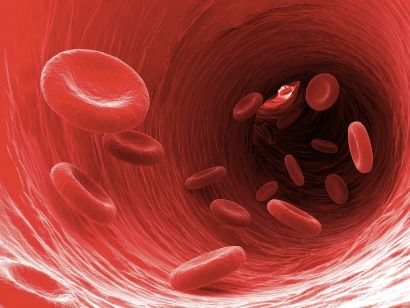In the last in our series on the “terrain,” we’ll take a look at Blood Circulation.
 When you are healthy, your blood is neither too thin nor too thick. If it becomes too viscous, it is in a state of hypercoagulation. This can happen when you have cancer: tumors cause clot-forming platelets to become overactive, and they stimulate production of a protein called fibrin, which kits blood cells together and thus makes the blood “sticky.” If your blood becomes too fluid or “thin,” on the other hand, it is in a state of hypocoagulation. This can happen from a loss of platelets, impairment in liver function, or use of anticoagulants, either pharmaceutical or nutritional. Too few platelets or their loss of “stickiness” can lead to capillary leakage or a full-blown hemorrhage. Both hypercoagulation and hypocoagulation are problematic. The first raises the risk of thrombi and embolisms and can promote tumor progression and metastasis. The second can lead to uncontrolled bleeding. These conditions are especially dangerous for cancer patients, because they have an impact on several aspects of your disease.
When you are healthy, your blood is neither too thin nor too thick. If it becomes too viscous, it is in a state of hypercoagulation. This can happen when you have cancer: tumors cause clot-forming platelets to become overactive, and they stimulate production of a protein called fibrin, which kits blood cells together and thus makes the blood “sticky.” If your blood becomes too fluid or “thin,” on the other hand, it is in a state of hypocoagulation. This can happen from a loss of platelets, impairment in liver function, or use of anticoagulants, either pharmaceutical or nutritional. Too few platelets or their loss of “stickiness” can lead to capillary leakage or a full-blown hemorrhage. Both hypercoagulation and hypocoagulation are problematic. The first raises the risk of thrombi and embolisms and can promote tumor progression and metastasis. The second can lead to uncontrolled bleeding. These conditions are especially dangerous for cancer patients, because they have an impact on several aspects of your disease.
What you can do:
To begin your self-care program for normalizing coagulation, make sure you are following the Life Over Cancer recommendations for diet, fitness and mind-spirit wellness. Then add these refinements:
- Eliminate clotting offenders: Cigarette smoke is the major clotting offender. It stimulates platelet aggregation, increase blood clotting, and increases blood levels of fibrinogen, thrombin, and other coagulation factors. Bottom line: do not smoke, and avoid secondhand smoke.
- Exercise: Being sedentary is bad for your clotting system. When you move around, the contractions of your leg muscles force blood to travel back to the heart. When you sit still for long periods, blood moves much more slowly. Exercise increases blood circulation and makes blood more fluid.
- Dietary changes: Reduce fat and dairy intake. Total fat intake has a strong effect on blood coagulation, increasing levels of clotting factors. Sticky blood is yet another reason to eat a diet low in total fat, by avoiding food high in saturated fats and cholesterol such as dairy products, butter, margarine, meat, coconut oil, shortening, partially hydrogenated fats, cottonseed oil, hydrogenated fats, and cottonseed oil. Omega-3 fats yield anticoagulant compounds when they are metabolized, while omega-6s tend to yield pro-coagulation chemicals such as thromboxane A2.
- High intake of dairy products may cause rapid blood coagulation. As we’ve mentioned before (for other reasons), reduce or avoid dairy and cow’s milk products, especially those with high levels of saturated fat such as ice cream, cream, whole milk, cheese and sour cream.
- Avoid high-protein diets. Popular high-protein diets can also induce hypercoagulation, apparently by raising levels of fibrinogen. The LOC diet can be adjusted to be vegetarian and even vegan, a healthy approach that Dr. Block speaks of frequently. However, a vegetarian diet should be designed carefully, and blood clotting is one reason why: if you avoid animal products entirely, you run the risk of becoming deficient in taurine, an amino acid found in animal foods that appears to be crucial to normal blood clotting. Low levels of vitamin B12 can increase homocysteine, which also promotes sticky blood. Vegetarians should ensure that their B12 levels are normal. If you do adopt a strict vegan diet, supplementation with vitamins and taurine will be helpful to avoid or correct an imbalance in coagulation.
For more information on The Block Center for Integrative Cancer Treatment, visit BlockMD.com.

